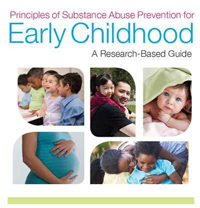The brain is an organ that adapts in both short- and long-term ways to its environment, and prevention science over the past few decades has shown clearly that a person's early experiences during the first few years of life and even prenatally can have an enormous impact on an individual's later risk or resilience for drug abuse and related psychiatric conditions. Thus NIDA is proud to announce the latest in our series of evidence-based guides for practitioners and researchers: Principles of Substance Abuse Prevention for Early Childhood
Infancy, toddlerhood, and the first years of school are hardly a time most people associate with drug use. But aspects of family, school, and community environments during this crucial window of human development can set the stage for the social, emotional, behavioral and academic problems that, a decade or more later, may take the form of increased risk-taking and experimentation with substances like alcohol, cigarettes, or illicit drugs. Early environments can even shape the developing brain in ways that make an individual more prone to developing substance use disorders. By the time a child reaches adolescence--the period of increased experimentation and onset of drug use--more effort is needed to shift the brain and behavior in a healthy direction. The new Guide describes the principles derived from research designing, implementing, and testing prevention programs aimed at the first 8 years of life (including prenatally) and the supporting data that have been gathered so far on 17 evidence-based prevention programs.
Central to intervening early is the idea of shifting the balance of risk and protective factors in a way that builds a foundation for optimal social development and resilience. For example, there is now substantial evidence that when parents are able to provide warmth, a supportive and stable home environment, adequate nutrition, and physical and cognitive stimulation during the early years of a child's life, their child is more likely to develop strong self-regulation abilities. Emotional and behavioral control can then, during the teen years, translate to greater ability to resist risky impulses and unhealthy forms of peer pressure. Interventions that help caregivers provide a healthy, supportive environment show positive outcomes such as delayed initiation of drug use and reduced adolescent drug use. Although the science is too young to have much data beyond adolescent outcomes, positive benefits of early intervention have been shown to extend in a few cases to young adulthood.
Research has also revealed that many early risk factors for substance abuse are also, simultaneously, risk factors for other behavioral and emotional problems. Acting aggressively and disruptively in preschool, for example, relates to increased risk for conduct disorders, substance use, delinquency, and risky sexual behaviors during adolescence. Thus interventions designed to reduce early risk factors show benefits in a wide range of areas--including improved personal and social functioning, better performance in school, and less involvement with the juvenile justice system or mental health services.
Like all investments, prevention costs money, but interventions more than pay for themselves in reduced costs later on. Where benefit-cost data for specific interventions are available, they can range from modestly good investments (a few dollars for every dollar invested) to overwhelmingly good investments ($26 for every dollar, in the case of one classroom-centered intervention component, the "Good Behavior Game"). Thus a well-designed, well-implemented early childhood intervention can dramatically benefit the community and society as well as improve children's and families' quality of life.
This new Guide reflects important new thinking about the roots of substance use and the ways to more effectively avert it. Intervening in the first years of a person's life can be an effective lever to set kids on a positive course and hopefully reduce the terrible toll associated with drug use and addiction.
This article was originally posted on www.drugabuse.gov.
